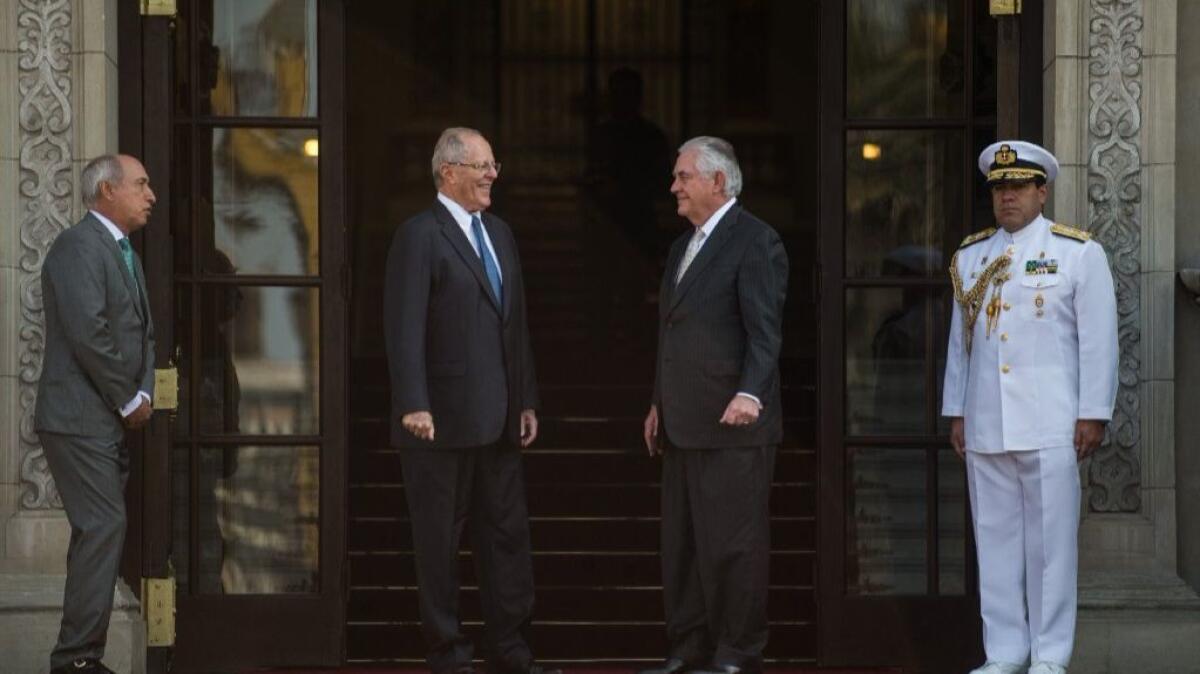Analysis: Tillerson travels the world as the Trump antidote

Secretary of State Rex Tillerson sat down with five presidents or prime ministers as he crossed Latin America and the Caribbean last week. On Sunday, he leaves for six days in five countries in the Middle East. Next month, he hits the road for 12 days in Africa.
It’s no mean feat, especially since in capital after capital, Tillerson has to finesse between supporting President Trump’s policies and repairing the damage from the president’s harsh tweets, belligerent speeches and vulgarities about America’s allies and adversaries alike.
For the record:
9:00 a.m. Feb. 9, 2018This story has been corrected to say that Secretary of State Rex Tillerson leaves on Sunday, not Saturday, for a trip to the Middle East.
A year into a job, the urbane former oil executive with the baritone Texas twang is making his mark not for imposing a bold foreign policy, or assembling a grand coalition. In many ways, Tillerson travels the world as the un-Trump.
“The president and I are pretty different individuals in terms of our management style, in terms of our communication style,” Tillerson told reporters traveling with him last week in Mexico, Colombia, Argentina, Peru and Jamaica.
“It doesn’t mean one is right, one is wrong, one is better, one is worse,” he added. “But we’re very different, and the way I process information and come to decisions is different from the way he does.”
In contrast to Vice President Mike Pence, who uses his overseas trips to publicly embrace and praise Trump, Tillerson delivers what often seem, if not directly opposing messages, certainly more nuanced ones.
While Pence paid homage to Trump at nearly every stop in the Middle East last month, and in Tokyo and Seoul this week, Tillerson mentioned the president occasionally and almost in passing while in Latin America.
Tillerson rejects any notion of a gulf between him and the president. But he spends a lot of time reassuring aggrieved allies and explaining what Trump really means on controversies as fraught as Middle East peace, the North Korean nuclear impasse, trade with Mexico and global warming — all issues where Tillerson has publicly differed with his boss.
Tillerson does not challenge Trump to his face in their regular White House lunches and meetings, nor in frequent telephone conversations, according to people familiar with their dealings. But he is willing to tell other nations that more thought goes into White House policy than meets the eye.
“The president’s tweets don’t define the policy,” Tillerson said.
Those who work with him say Tillerson is unflappable and steely-focused on making concrete arguments with the leaders he meets despite the sound and fury in Washington. Still, some foreign leaders and diplomats are left wondering whose voice speaks loudest, whom to believe, who is in charge when the White House and its chief diplomat espouse different views.
Confusing issues further, the State Department has reeled in or corrected several hawkish statements by the U.S. ambassador to the United Nations, Nikki Haley, who is said to be close to Trump and at odds with Tillerson.
The contrasts sometimes play out in real time. In Mexico City last week, Tillerson held a news conference with Mexican Foreign Minister Luis Videgaray and stuck to pro forma comments praising friendship between the two countries. “We still value immigrants,” Tillerson said.
At nearly the same time, Trump met with Homeland Security officials in Sterling, Va., reiterated his plans to build a wall along the U.S. border with Mexico, an idea Mexico has roundly rejected, and threatened to cut off aid to unnamed Latin countries that don’t do enough to support U.S. policies.
A senior official on the Tillerson trip called Trump’s comments “unhelpful,” unusually frank criticism from a diplomat.
In Peru and in Colombia, Tillerson sought regional support for stiffer economic sanctions against the government in Venezuela — but was grilled by local reporters and officials about why his comments differed from those emanating from the White House.
In Kingston, Jamaica, a reporter for state television pressed Tillerson to explain Trump’s reported description of largely nonwhite countries as “shitholes.”
“How should we perceive your visit today,” asked the reporter, Andrea Chisholm, “and how can Caribbean countries think that you respect us, and it’s not more of the United States just throwing their power around?”
Tillerson responded that he was there “to reinforce the partnership” with Jamaica and the Caribbean region.
An American reporter later asked if Tillerson was frustrated at being repeatedly pushed off message by the president.
“I don’t get frustrated about anything, so I don’t need to answer the question,” he said.
A senior State Department official said U.S. relations with most governments in Latin America are “robust” enough to weather the White House jibes. But privately, many Latin American officials are waiting to see how much of what Trump has promised — or threatened — to do actually gets done.
Colombia is already seeing Obama administration pledges of billions of dollars in U.S. aid begin to evaporate, just as it attempts to put into place an expensive peace agreement aimed at ending four decades of war.
“It is confusing,” said Bruce Bagley, a Latin America expert and international relations professor at the University of Miami. “It is not clear who is to be believed, who is speaking for the administration, who is speaking for America.
“Is Tillerson a trial balloon? Is he just cosmetic?” Bagley said. “Right now, I don’t think Tillerson has much credibility.”
That’s certainly his reputation in large parts of the State Department. His decision to accept drastic budget cuts, his propensity to micromanage, and his plans to sharply reduce staff and reorganize the foreign policy bureaucracy have fueled sharp criticism of his style and agenda.
It did not help when the knives came out early on, somewhere near the Oval Office, when senior aides to Trump leaked that Tillerson’s firing or resignation was imminent. A news report in October that he had privately referred to Trump as a “moron” — a characterization Tillerson did not explicitly deny making — seemed to seal his fate.
But Tillerson appears to have dug in instead. And if his travel schedule is any indication, the 65-year-old former CEO of Exxon Mobil may be safe in the ornate, mahogany-paneled offices on the seventh floor of the State Department, at least for now.
“My job as secretary of State is to develop a lot of options, alternative ways of looking at the issue, present those as best I can, make a recommendation, if [the president] wants me to make one,” Tillerson said. “And then let him make the decision and whatever he decides, we’ll go execute that and develop all the right tactics and strategies to do that.
“That’s my job.”
For more on international affairs, follow @TracyKWilkinson on Twitter
More to Read
Start your day right
Sign up for Essential California for news, features and recommendations from the L.A. Times and beyond in your inbox six days a week.
You may occasionally receive promotional content from the Los Angeles Times.






